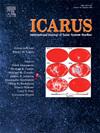水冰和月球高地模拟混合物的可见至近红外光谱的实验室实验:颗粒大小、颗粒形状、相位角和冰丰度的影响
IF 2.5
2区 物理与天体物理
Q2 ASTRONOMY & ASTROPHYSICS
引用次数: 0
摘要
在月球两极附近的永久阴影区(PSRs)已经检测到表层水冰。水冰在1.0、1.25、1.5、2.0 μm处具有诊断吸收特征,且在VIS区具有较高的反射率。然而,颗粒大小和形状、冰丰度和相位角对冰混合物近红外光谱的影响仍然知之甚少,这对探测月球表面的水冰构成了挑战。在这项研究中,我们测量了纯水冰和水冰与月球高原风化模拟物(HRS)的混合物的近红外光谱。我们研究了冰的粒径(0 ~ 250 μm)、冰的颗粒形状(角状或球形)、相位角(0 ~ 105°)和冰的丰度(0 ~ 50 wt%)对水冰和HRS混合物350 ~ 2500 nm近红外光谱的影响。我们的研究结果表明,较粗的冰粒表现出更强的近红外吸收和较低的VIS反射率,这是由于较长的光路长度增加了光子吸收。同样,球形粒子相对于角粒子的光路长度较长,导致较低的VIS反射率。水冰的前向散射特性导致高相位角(>90°)时VIS反射率增加,表明高相位角是探测月球水冰的最佳选择。相位角对冰的近红外吸收强度的影响可以忽略不计,特别是当冰以低冰丰度(< 20wt %)存在于与HRS的密切混合物中时。最后,我们的研究结果表明,在非常低的冰浓度(0-5 wt%)下,近红外吸收在1.25、1.5和2.0 μm附近迅速加深。我们还发现,在含有0-50 wt%冰的HRS的亲密混合物中,VIS反射率与冰含量之间存在线性关系。这项研究的发现为通过近红外光谱探测和分析月球表面的水冰提供了一个详细的框架。本文章由计算机程序翻译,如有差异,请以英文原文为准。
Laboratory experiments on the visible to near- infrared (VNIR) spectroscopy of water ice and lunar highland simulant mixtures: Effects of particle size, particle shape, phase angle, and ice abundance
Surficial water ice has been detected in the permanently shaded regions (PSRs) near the lunar poles. Water ice can be detected by its diagnostic absorption features of ice at 1.0, 1.25, 1.5, and 2.0 μm, as well as high reflectance in the VIS region. However, the effects of particle size and shape, ice abundance, and phase angle on the VNIR spectra of ice mixtures remain poorly understood, posing a challenge for detections of water ice on the lunar surface. In this study, we measured the VNIR spectra of pure water ice and mixtures of water ice and a lunar highland regolith simulant (HRS). We investigated the effects of particle size of ice (0–250 μm), particle shape of ice (angular vs. spherical), phase angle (0–105°), and ice abundance (0–50 wt%) on the VNIR spectra of water ice and HRS mixtures from 350 to 2500 nm. Our results show that coarser ice particles exhibit stronger NIR absorptions and lower VIS reflectance, attributable to increased photon absorptions due to longer optical pathlengths. Similarly, the longer optical pathlengths of spherical particles relative to angular ones result in lower VIS reflectance. The forward scattering nature of water ice leads to increased VIS reflectance at high phase angles (>90°), suggesting that high phase angles are optimal for lunar water ice detection. Phase angles have a negligible effect on the strength of the NIR absorptions of ice, especially when ice is present at low ice abundances (<20 wt%) in intimate mixtures with the HRS. Lastly, our findings suggest that the NIR absorptions near 1.25, 1.5, and 2.0 μm rapidly deepen at very low ice concentrations (0–5 wt%). We also find a linear relationship between VIS reflectance and ice content in intimate mixtures with a HRS containing 0–50 wt% ice. The findings of this study offer a detailed framework for detecting and analyzing water ice on the lunar surface via VNIR spectroscopy.
求助全文
通过发布文献求助,成功后即可免费获取论文全文。
去求助
来源期刊

Icarus
地学天文-天文与天体物理
CiteScore
6.30
自引率
18.80%
发文量
356
审稿时长
2-4 weeks
期刊介绍:
Icarus is devoted to the publication of original contributions in the field of Solar System studies. Manuscripts reporting the results of new research - observational, experimental, or theoretical - concerning the astronomy, geology, meteorology, physics, chemistry, biology, and other scientific aspects of our Solar System or extrasolar systems are welcome. The journal generally does not publish papers devoted exclusively to the Sun, the Earth, celestial mechanics, meteoritics, or astrophysics. Icarus does not publish papers that provide "improved" versions of Bode''s law, or other numerical relations, without a sound physical basis. Icarus does not publish meeting announcements or general notices. Reviews, historical papers, and manuscripts describing spacecraft instrumentation may be considered, but only with prior approval of the editor. An entire issue of the journal is occasionally devoted to a single subject, usually arising from a conference on the same topic. The language of publication is English. American or British usage is accepted, but not a mixture of these.
 求助内容:
求助内容: 应助结果提醒方式:
应助结果提醒方式:


